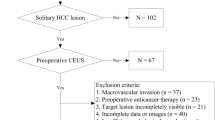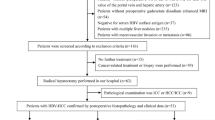Abstract
Objectives
The aim of this study was to evaluate the potential of Sonazoid contrast-enhanced ultrasound (SNZ-CEUS) as an imaging biomarker for preoperative prediction of microvascular invasion (MVI) in hepatocellular carcinoma (HCC).
Methods
From August 2020 to March 2021, we conducted a prospective multicenter study on the clinical application of Sonazoid in liver tumor; a MVI prediction model was developed and validated by integrating clinical and imaging variables. Multivariate logistic regression analysis was used to establish the MVI prediction model; three models were developed: a clinical model, a SNZ-CEUS model, and a combined model and conduct external validation. We conducted subgroup analysis to investigate the performance of the SNZ-CEUS model in non-invasive prediction of MVI.
Results
Overall, 211 patients were evaluated. All patients were split into derivation (n = 170) and external validation (n = 41) cohorts. Patients who had MVI accounted for 89 of 211 (42.2%) patients. Multivariate analysis revealed that tumor size (> 49.2 mm), pathology differentiation, arterial phase heterogeneous enhancement pattern, non-single nodular gross morphology, washout time (< 90 s), and gray value ratio (≤ 0.50) were significantly associated with MVI. Combining these factors, the area under the receiver operating characteristic (AUROC) of the combined model in the derivation and external validation cohorts was 0.859 (95% confidence interval (CI): 0.803–0.914) and 0.812 (95% CI: 0.691–0.915), respectively. In subgroup analysis, the AUROC of the SNZ-CEUS model in diameter ≤ 30 mm and ˃ 30 mm cohorts were 0.819 (95% CI: 0.698–0.941) and 0.747 (95% CI: 0.670–0.824).
Conclusions
Our model predicted the risk of MVI in HCC patients with high accuracy preoperatively.
Clinical relevance statement
Sonazoid, a novel second-generation ultrasound contrast agent, can accumulate in the endothelial network and form a unique Kupffer phase in liver imaging. The preoperative non-invasive prediction model based on Sonazoid for MVI is helpful for clinicians to make individualized treatment decisions.
Key Points
• This is the first prospective multicenter study to analyze the possibility of SNZ-CEUS preoperatively predicting MVI.
• The model established by combining SNZ-CEUS image features and clinical features has high predictive performance in both derivation cohort and external validation cohort.
• The findings can help clinicians predict MVI in HCC patients before surgery and provide a basis for optimizing surgical management and monitoring strategies for HCC patients.




Similar content being viewed by others
Abbreviations
- AP:
-
Arterial phase
- AUROC:
-
Area under the receiver operating characteristic
- CEUS:
-
Contrast-enhanced ultrasonography
- CI:
-
Confidence interval
- DP:
-
Delay phase
- HCC:
-
Hepatocellular carcinoma
- KP:
-
Kupffer phase
- MVI:
-
Microvascular invasion
- OR:
-
Odds ratio
- PVP:
-
Portal venous phase
- ROI:
-
Region of interest
- SNZ-CEUS:
-
Sonazoid contrast-enhanced ultrasound
References
Sung H, Ferlay J, Siegel RL et al (2021) Global cancer statistics 2020: GLOBOCAN estimates of incidence and mortality worldwide for 36 cancers in 185 countries. CA Cancer J Clin 71:209–249. https://doi.org/10.3322/caac.21660
Reig M, Forner A, Rimola J et al (2022) BCLC strategy for prognosis prediction and treatment recommendation: the 2022 update. J Hepatol 76:681–693. https://doi.org/10.1016/j.jhep.2021.11.018
Li Y, Zhang Y, Fang Q et al (2021) Radiomics analysis of [(18)F]FDG PET/CT for microvascular invasion and prognosis prediction in very-early- and early-stage hepatocellular carcinoma. Eur J Nucl Med Mol Imaging 48:2599–2614. https://doi.org/10.1007/s00259-020-05119-9
Erstad DJ, Tanabe KK (2019) Prognostic and therapeutic implications of microvascular invasion in hepatocellular carcinoma. Ann Surg Oncol 26:1474–1493. https://doi.org/10.1245/s10434-019-07227-9
Tang Y, Xu L, Ren Y et al (2022) Identification and validation of a prognostic model based on three MVI-related genes in hepatocellular carcinoma. Int J Biol Sci 18:261–275. https://doi.org/10.7150/ijbs.66536
Ji GW, Zhu FP, Xu Q et al (2020) Radiomic features at contrast-enhanced CT predict recurrence in early stage hepatocellular carcinoma: a multi-institutional study. Radiology 294:568–579. https://doi.org/10.1148/radiol.2020191470
Banerjee S, Wang DS, Kim HJ et al (2015) A computed tomography radiogenomic biomarker predicts microvascular invasion and clinical outcomes in hepatocellular carcinoma. Hepatology 62:792–800. https://doi.org/10.1002/hep.27877
Lee S, Kang TW, Song KD et al (2021) Effect of microvascular invasion risk on early recurrence of hepatocellular carcinoma after surgery and radiofrequency ablation. Ann Surg 273:564–571. https://doi.org/10.1097/SLA.0000000000003268
Hyun SH, Eo JS, Song BI et al (2018) Preoperative prediction of microvascular invasion of hepatocellular carcinoma using (18)F-FDG PET/CT: a multicenter retrospective cohort study. Eur J Nucl Med Mol Imaging 45:720–726. https://doi.org/10.1007/s00259-017-3880-4
Kudo M (2016) Defect reperfusion imaging with Sonazoid(R): a breakthrough in hepatocellular carcinoma. Liver Cancer 5:1–7. https://doi.org/10.1159/000367760
Moons KG, Altman DG, Reitsma JB et al (2015) Transparent reporting of a multivariable prediction model for individual prognosis or diagnosis (TRIPOD): explanation and elaboration. Ann Intern Med 162:1–73. https://doi.org/10.7326/M14-0698
Washington MK, Goldberg RM, Chang GJ et al (2021) Diagnosis of digestive system tumours. Int J Cancer 148:1040–1050. https://doi.org/10.1002/ijc.33210
Chen L, Chen S, Zhou Q et al (2021) Microvascular invasion status and its survival impact in hepatocellular carcinoma depend on tissue sampling protocol. Ann Surg Oncol 28:6747–6757. https://doi.org/10.1245/s10434-021-09673-w
Dietrich CF, Nolsoe CP, Barr RG et al (2020) Guidelines and good clinical practice recommendations for contrast enhanced ultrasound (CEUS) in the liver - update 2020 - WFUMB in Cooperation with EFSUMB, AFSUMB, AIUM, and FLAUS. Ultraschall Med 41:562–585. https://doi.org/10.1055/a-1177-0530
Shirabe K, Aishima S, Taketomi A et al (2011) Prognostic importance of the gross classification of hepatocellular carcinoma in living donor-related liver transplantation. Br J Surg 98:261–267. https://doi.org/10.1002/bjs.7311
Tada T, Kumada T, Toyoda H et al (2015) Utility of contrast-enhanced ultrasonography with perflubutane for determining histologic grade in hepatocellular carcinoma. Ultrasound Med Biol 41:3070–3078. https://doi.org/10.1016/j.ultrasmedbio.2015.07.023
Sidhu PS, Cantisani V, Dietrich CF et al (2018) The EFSUMB guidelines and recommendations for the clinical practice of contrast-enhanced ultrasound (CEUS) in non-hepatic applications: update 2017 (long version). Ultraschall Med 39:2–44. https://doi.org/10.1055/a-0586-1107
Xie DY, Ren ZG, Zhou J, Fan J, Gao Q (2020) 2019 Chinese clinical guidelines for the management of hepatocellular carcinoma: updates and insights. Hepatobiliary Surg Nutr 9:452–463. https://doi.org/10.21037/hbsn-20-480
Hatanaka K, Kudo M, Minami Y, Maekawa K (2008) Sonazoid-enhanced ultrasonography for diagnosis of hepatic malignancies: comparison with contrast-enhanced CT. Oncology 75:42–47. https://doi.org/10.1159/000173423
Yanagisawa K, Moriyasu F, Miyahara T, Yuki M, Iijima H (2007) Phagocytosis of ultrasound contrast agent microbubbles by Kupffer cells. Ultrasound Med Biol 33:318–325. https://doi.org/10.1016/j.ultrasmedbio.2006.08.008
Kaibori M, Ishizaki M, Matsui K, Kwon AH (2010) Predictors of microvascular invasion before hepatectomy for hepatocellular carcinoma. J Surg Oncol 102:462–468. https://doi.org/10.1002/jso.21631
Iguchi T, Shirabe K, Aishima S et al (2015) New pathologic stratification of microvascular invasion in hepatocellular carcinoma: predicting prognosis after living-donor liver transplantation. Transplantation 99:1236–1242. https://doi.org/10.1097/TP.0000000000000489
Cucchetti A, Piscaglia F, Grigioni AD et al (2010) Preoperative prediction of hepatocellular carcinoma tumour grade and micro-vascular invasion by means of artificial neural network: a pilot study. J Hepatol 52:880–888. https://doi.org/10.1016/j.jhep.2009.12.037
Nathani P, Gopal P, Rich N et al (2021) Hepatocellular carcinoma tumour volume doubling time: a systematic review and meta-analysis. Gut 70:401–407. https://doi.org/10.1136/gutjnl-2020-321040
Fu R, Li Y, Jiang N et al (2020) Inactivation of endothelial ZEB1 impedes tumor progression and sensitizes tumors to conventional therapies. J Clin Invest 130:1252–1270. https://doi.org/10.1172/JCI131507
Dong Y, Qiu Y, Yang D et al (2021) Potential application of dynamic contrast enhanced ultrasound in predicting microvascular invasion of hepatocellular carcinoma. Clin Hemorheol Microcirc 77:461–469. https://doi.org/10.3233/CH-201085
Rodriguez-Peralvarez M, Luong TV, Andreana L, Meyer T, Dhillon AP, Burroughs AK (2013) A systematic review of microvascular invasion in hepatocellular carcinoma: diagnostic and prognostic variability. Ann Surg Oncol 20:325–339. https://doi.org/10.1245/s10434-012-2513-1
Sumie S, Kuromatsu R, Okuda K et al (2008) Microvascular invasion in patients with hepatocellular carcinoma and its predictable clinicopathological factors. Ann Surg Oncol 15:1375–1382. https://doi.org/10.1245/s10434-008-9846-9
Gouw AS, Balabaud C, Kusano H, Todo S, Ichida T, Kojiro M (2011) Markers for microvascular invasion in hepatocellular carcinoma: where do we stand? Liver Transpl 17:72–80. https://doi.org/10.1002/lt.22368
Tanaka H, Iijima H, Higashiura A et al (2014) New malignant grading system for hepatocellular carcinoma using the Sonazoid contrast agent for ultrasonography. J Gastroenterol 49:755–763. https://doi.org/10.1007/s00535-013-0830-1
Goto E, Masuzaki R, Tateishi R et al (2012) Value of post-vascular phase (Kupffer imaging) by contrast-enhanced ultrasonography using Sonazoid in the detection of hepatocellular carcinoma. J Gastroenterol 47:477–485. https://doi.org/10.1007/s00535-011-0512-9
Matsumoto N, Ogawa M, Kaneko M et al (2021) Quantitative ultrasound image analysis helps in the differentiation of hepatocellular carcinoma (HCC) from borderline lesions and predicting the histologic grade of HCC and microvascular invasion. J Ultrasound Med 40:689–698. https://doi.org/10.1002/jum.15439
Chong HH, Yang L, Sheng RF et al (2021) Multi-scale and multi-parametric radiomics of gadoxetate disodium-enhanced MRI predicts microvascular invasion and outcome in patients with solitary hepatocellular carcinoma </= 5 cm. Eur Radiol 31:4824–4838. https://doi.org/10.1007/s00330-020-07601-2
Ma X, Wei J, Gu D et al (2019) Preoperative radiomics nomogram for microvascular invasion prediction in hepatocellular carcinoma using contrast-enhanced CT. Eur Radiol 29:3595–3605. https://doi.org/10.1007/s00330-018-5985-y
Acknowledgements
We would like to acknowledge the effort of clinical data collection from Pingping Zhou (Affiliated Tongji Hospital of Tongji Medical College, Huazhong University of Science and Technology), Jinshu Pang (the First Affiliated Hospital of Guangxi Medical University), Wenhan Xu (Huashan Hospital, Fudan University), Ling Gao (West China Hospital, Sichuan University), Qiannan Huang (the Third Affiliated Hospital of Sun Yat-sen University), Rui Zhang (the First Affiliated Hospital of Sun Yat-sen University), Kun Zhao (Peking University Cancer Hospital & Institute), and Xu Wang (the Third Central Hospital of Tianjin).
Funding
This study was funded by the National Natural Science Foundation of China (Grant No. 92159305, 82227804, 82172027).
Author information
Authors and Affiliations
Corresponding authors
Ethics declarations
Guarantor
The scientific guarantor of this publication is XiaoLing Yu.
Conflict of interest
The authors of this manuscript declare no competing interests.
Statistics and biometry
No complex statistical methods were necessary for this paper.
Informed consent
Written informed consent was obtained from all patients in this study.
Ethical approval
The study protocol was approved by the Institutional Review Boards of PLA General Hospital S2020-300-01.
Methodology
• prospective
• diagnostic or prognostic study
• multicenter study
Additional information
Publisher's note
Springer Nature remains neutral with regard to jurisdictional claims in published maps and institutional affiliations.
Supplementary Information
Below is the link to the electronic supplementary material.
Rights and permissions
Springer Nature or its licensor (e.g. a society or other partner) holds exclusive rights to this article under a publishing agreement with the author(s) or other rightsholder(s); author self-archiving of the accepted manuscript version of this article is solely governed by the terms of such publishing agreement and applicable law.
About this article
Cite this article
Yao, J., Li, K., Yang, H. et al. Analysis of Sonazoid contrast-enhanced ultrasound for predicting the risk of microvascular invasion in hepatocellular carcinoma: a prospective multicenter study. Eur Radiol 33, 7066–7076 (2023). https://doi.org/10.1007/s00330-023-09656-3
Received:
Revised:
Accepted:
Published:
Issue Date:
DOI: https://doi.org/10.1007/s00330-023-09656-3




